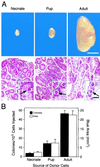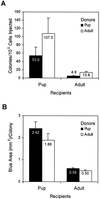Remodeling of the postnatal mouse testis is accompanied by dramatic changes in stem cell number and niche accessibility
- PMID: 11371640
- PMCID: PMC33443
- DOI: 10.1073/pnas.111158198
Remodeling of the postnatal mouse testis is accompanied by dramatic changes in stem cell number and niche accessibility
Abstract
Little is known about stem cell biology or the specialized environments or niches believed to control stem cell renewal and differentiation in self-renewing tissues of the body. Functional assays for stem cells are available only for hematopoiesis and spermatogenesis, and the microenvironment, or niche, for hematopoiesis is relatively inaccessible, making it difficult to analyze donor stem cell colonization events in recipients. In contrast, the recently developed spermatogonial stem cell assay system allows quantitation of individual colonization events, facilitating studies of stem cells and their associated microenvironment. By using this assay system, we found a 39-fold increase in male germ-line stem cells during development from birth to adult in the mouse. However, colony size or area of spermatogenesis generated by neonate and adult stem cells, 2-3 months after transplantation into adult tubules, was similar ( approximately 0.5 mm(2)). In contrast, the microenvironment in the immature pup testis was 9.4 times better than adult testis in allowing colonization events, and the area colonized per donor stem cell, whether from adult or pup, was about 4.0 times larger in recipient pups than adults. These factors facilitated the restoration of fertility by donor stem cells transplanted to infertile pups. Thus, our results demonstrate that stem cells and their niches undergo dramatic changes in the postnatal testis, and the microenvironment of the pup testis provides a more hospitable environment for transplantation of male germ-line stem cells.
Figures



References
Publication types
MeSH terms
Grants and funding
LinkOut - more resources
Full Text Sources
Medical

